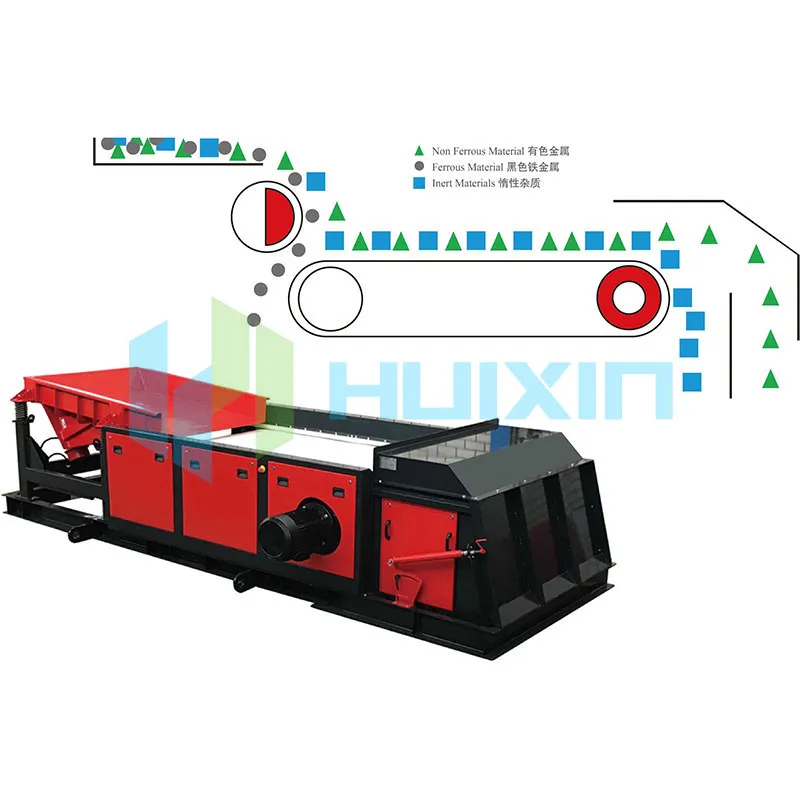 English
English Español
Español  Português
Português  русский
русский  Français
Français  日本語
日本語  Deutsch
Deutsch  tiếng Việt
tiếng Việt  Italiano
Italiano  Nederlands
Nederlands  ภาษาไทย
ภาษาไทย  Polski
Polski  한국어
한국어  Svenska
Svenska  magyar
magyar  Malay
Malay  বাংলা ভাষার
বাংলা ভাষার  Dansk
Dansk  Suomi
Suomi  हिन्दी
हिन्दी  Pilipino
Pilipino  Türkçe
Türkçe  Gaeilge
Gaeilge  العربية
العربية  Indonesia
Indonesia  Norsk
Norsk  تمل
تمل  český
český  ελληνικά
ελληνικά  український
український  Javanese
Javanese  فارسی
فارسی  தமிழ்
தமிழ்  తెలుగు
తెలుగు  नेपाली
नेपाली  Burmese
Burmese  български
български  ລາວ
ລາວ  Latine
Latine  Қазақша
Қазақша  Euskal
Euskal  Azərbaycan
Azərbaycan  Slovenský jazyk
Slovenský jazyk  Македонски
Македонски  Lietuvos
Lietuvos  Eesti Keel
Eesti Keel  Română
Română  Slovenski
Slovenski  मराठी
मराठी  Srpski језик
Srpski језик
Nonferrous Metal Sorting System: A Game Changer in Recycling and Resource Management
2024-10-08
As global industries continue to grow, the need for efficient recycling and resource management has never been greater. In the realm of metal recycling, one critical aspect is the sorting of nonferrous metals, which include valuable materials like aluminum, copper, zinc, and lead. These metals, unlike ferrous metals (which contain iron), do not rust and have significant industrial value. The Nonferrous Metal Sorting System plays a vital role in efficiently separating these metals from waste, enhancing recycling processes, reducing environmental impact, and contributing to sustainable resource management.

1. What Are Nonferrous Metals?
Before diving into the sorting systems, it’s essential to understand what nonferrous metals are and why they are important. Nonferrous metals are those that do not contain iron and, as a result, are generally more resistant to corrosion and rust. They also tend to have unique properties such as lightweight characteristics, high conductivity, and superior resistance to chemical and environmental damage. Common nonferrous metals include:
- Aluminum: Known for its light weight and resistance to corrosion, aluminum is widely used in packaging, automotive, and construction industries.
- Copper: With excellent electrical conductivity, copper is essential in electrical wiring, electronics, and plumbing.
- Zinc: Primarily used for galvanizing steel to prevent rust, zinc is also a key element in batteries and die-casting processes.
- Lead: A dense, malleable metal, lead is used in batteries, shielding against radiation, and some construction materials.
Nonferrous metals are often more valuable than ferrous metals due to their unique properties and wide range of industrial applications, making their efficient recovery and recycling a priority.
2. The Need for Nonferrous Metal Sorting Systems
In any recycling facility, the goal is to efficiently and accurately sort valuable materials from waste. Nonferrous metals, in particular, are often mixed with other materials like plastics, ferrous metals, and even organic waste, making the sorting process more challenging. Traditional methods of sorting nonferrous metals, such as manual sorting or basic mechanical separation, are labor-intensive, slow, and prone to error.
As the volume of waste increases, industries have shifted toward automated nonferrous metal sorting systems, which use advanced technologies to separate metals with greater speed, precision, and consistency. These systems not only enhance recycling rates but also maximize the recovery of valuable metals, reducing the need for virgin material extraction and promoting a circular economy.
3. How Nonferrous Metal Sorting Systems Work
Nonferrous metal sorting systems rely on various technologies and techniques to accurately and efficiently separate metals from mixed waste streams. Here are some of the most common methods used in these systems:
3.1. Eddy Current Separation
The eddy current separator is one of the most widely used technologies for sorting nonferrous metals. This method exploits the differences in electrical conductivity between nonferrous metals and other materials.
How it works:
- The waste stream is passed over a rotating drum with a strong magnetic field.
- As nonferrous metals like aluminum or copper pass through the magnetic field, they induce an electrical current, creating a magnetic force in the opposite direction.
- This force "pushes" the nonferrous metals away from the waste stream, separating them from other materials such as plastics or glass.
Advantages:
- High Efficiency: Eddy current separators can quickly and accurately separate nonferrous metals from mixed waste streams, even when these metals are in small quantities.
- Versatility: This method works on a wide range of nonferrous metals, including aluminum, copper, and brass.
3.2. X-Ray Transmission (XRT) Sorting
X-ray transmission technology is another advanced method used to separate nonferrous metals, especially when dealing with more complex or heavily contaminated waste streams.
How it works:
- X-ray sensors analyze the atomic density of materials in the waste stream.
- Nonferrous metals, which have a higher atomic density compared to plastics or glass, are identified by the X-ray sensors.
- Once identified, these metals are automatically sorted from the waste stream using air jets or mechanical arms.
Advantages:
- High Precision: XRT sorting can detect and separate even small particles of nonferrous metals with a high degree of accuracy.
- Applicable for Heavy Contaminants: This method is highly effective for sorting metals in waste streams that contain complex mixtures of materials.
3.3. Optical Sorting
In optical sorting systems, advanced cameras and sensors are used to identify different materials based on their color, size, and reflectivity. This method can be particularly useful in distinguishing between nonferrous metals like aluminum and copper.
How it works:
- Cameras scan the waste stream, and software analyzes the material composition in real-time.
- Once nonferrous metals are identified, mechanical sorting arms or air jets are used to remove them from the waste stream.
Advantages:
- Fast Processing: Optical sorting systems can process large volumes of waste quickly, making them suitable for high-capacity recycling facilities.
- High Accuracy: Advanced algorithms help ensure that nonferrous metals are sorted with minimal errors.
3.4. Sensor-Based Sorting
Sensor-based sorting systems combine various detection technologies, such as X-rays, infrared, and laser-induced breakdown spectroscopy (LIBS), to identify and sort nonferrous metals from mixed waste streams.
How it works:
- Sensors detect specific characteristics of materials, such as elemental composition, density, or molecular structure.
- Once nonferrous metals are identified, automated systems segregate them from other waste materials.
Advantages:
- Broad Application: This method can be tailored to different types of nonferrous metals and waste streams.
- Precise Separation: It allows for the recovery of high-purity metal fractions.
4. Benefits of Nonferrous Metal Sorting Systems
Investing in a nonferrous metal sorting system offers several key advantages for recycling companies, industries, and the environment:
4.1. Increased Recycling Efficiency
Automated systems significantly increase the speed and accuracy of sorting, allowing for higher throughput in recycling facilities. This leads to greater recovery of nonferrous metals, maximizing the recycling potential of each waste stream.
4.2. Reduced Environmental Impact
By improving the recovery of nonferrous metals, these systems reduce the demand for virgin material extraction, which is often environmentally damaging. Additionally, recycling metals requires far less energy than mining and refining raw ores, leading to lower greenhouse gas emissions.
4.3. Economic Benefits
Nonferrous metals, especially aluminum and copper, hold considerable value in global markets. Sorting systems that efficiently recover these metals can generate significant revenue for recycling companies while also reducing disposal costs.
4.4. Enhanced Product Quality
Advanced sorting technologies result in higher-purity metal fractions, making the recycled materials more valuable and suitable for high-end manufacturing applications.
5. Future Innovations in Nonferrous Metal Sorting
The field of nonferrous metal sorting is constantly evolving, with new innovations aimed at improving the efficiency and accuracy of these systems. Some emerging trends include:
- AI-Powered Sorting: Artificial intelligence (AI) is being integrated into sorting systems to improve real-time decision-making and increase the accuracy of material identification.
- Robotics: Robotic systems are being developed to complement sensor-based sorting, providing greater flexibility and precision in handling complex waste streams.
- Sustainability Initiatives: As global demand for sustainable practices grows, future sorting systems will likely focus on reducing energy consumption and minimizing waste during the recycling process.
Nonferrous metal sorting systems are an essential part of the recycling industry, providing a solution to the growing need for efficient resource management. Through advanced technologies like eddy current separation, X-ray transmission, and optical sorting, these systems offer high levels of precision and efficiency in recovering valuable metals from mixed waste streams. As industries continue to prioritize sustainability, nonferrous metal sorting systems will play an increasingly important role in reducing environmental impact and promoting a circular economy.
Fujian huixin environmental technology co., LTD. (formerly name:quanzhou city licheng huangshi machinery co., LTD.) is a professional manufacturer that produce various kinds of environmental machine since 1989,which is committed to high-tech environmental technology research and innovation, product production, sales and maintenance. Our Products are waste incinerator, waste incinerator, mobile pyrolysis furnace, smoke treatment system, waste solidification processing system and ohter environmental equipment. Find detailed product information on our website at https://www.incineratorsupplier.com/. Should you have any inquiries, don't hesitate to contact us at hxincinerator@foxmail.com.




